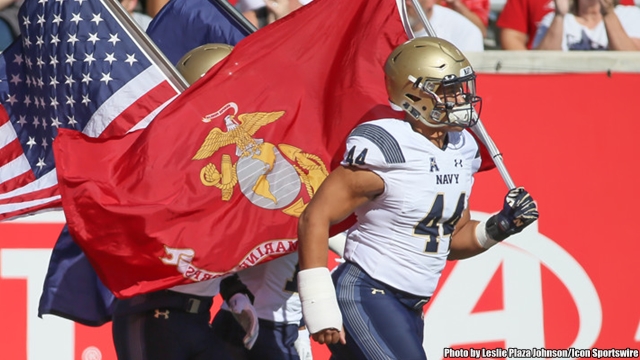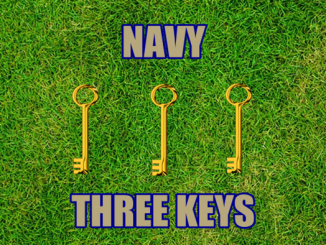
Imagine typing this sentence: Army scored 56 points, Air Force allowed only 229 total yards, Navy covered the spread by 20 points, and none of them won at home.
That’s an incredible sentence. Imagine saying that, thinking that, or reading that at any point in your LIFE. We’re not referring to the past three years or the past 10 years or the past 25 years. Imagine looking at those words at any stage of your sojourn here on Earth – when you were five, or 10, or 18, or 27, or 33, or 45, or 58, or 71 years old, any age at all – and thinking they could possibly be true. It’s all so completely absurd and ridiculous.
No way, no how, not ever, no chance, no sir.
But it’s real. It’s actually true. This stuff really did happen over the weekend, one of the most Murphy’s Law weekends one can remember for the service academies as a collective whole.
Army really did score 56 points at Michie Stadium and lose. Not only that, it lost by more than one score. Wake Forest put up 70 as Dave Clawson’s Demon Deacons remained unbeaten in the 2021 season, in pursuit of a top-tier bowl bid. Sam Hartman threw for 461 yards and five touchdowns with no interceptions. Army clearly had not seen a passing offense like this, and the Black Knights couldn’t keep up with the Demon Deacons’ speedy pass-catchers.
The fireworks show by Wake Forest overshadowed an amazing performance by Army’s offense. The passing game produced one of the best passing stat lines in the Jeff Monken era: 10-of-13 completions for 179 yards and three touchdowns with one interception. Army rushed for 416 yards. Three different Army rushers tallied at least 93 yards. That’s more than Monken and his staff could possibly ask for.
Again, though, with all of that phenomenal offensive production at home, the Black Knights lost by 14 points.
Hard to believe, but it’s true.
The “hard to believe” tour continues in Colorado Springs, where Air Force’s defense did everything it realistically could have been expected to do. The Falcons limited San Diego State to 229 yards, just 72 in the air. Air Force played airtight defense and did not allow a scuffling San Diego State offense to bust loose and find rhythm.
How did the Falcons lose, 20-14? This was a disaster on offense. Air Force missed a blocking assignment on a fourth and 1 near midfield, failing on downs and giving San Diego State a short field. Two turnovers gave San Diego State more short-field opportunities. The Aztecs cashed these various mistakes into a majority of the 20 points they scored.
Air Force also went just 4 of 16 on third-down conversions. The Falcons dropped a long pass which would have scored a touchdown. Late in the game, down by only six, San Diego State lost focus in its downfield pass coverage. A post pattern broke wide open for at least a 50-yard gain if not a 70-yard gain or an outright score, but the ball was overthrown vertically instead of leading the receiver diagonally across the field.
It’s not so much that Air Force made mistakes; sports are imperfect, given that human beings are imperfect. However, Air Force’s mistakes came at the worst possible times, in the game’s most critical hinge-point moments. Every particularly important play featured an Air Force mistake. San Diego State didn’t move the ball consistently and didn’t get much out of its passing game, but the no-mistake approach by the Aztecs, who did not commit a turnover and did not concede short fields to Air Force, was enough for them to stay unbeaten and maintain a lead in the Mountain West.
The only good news for Air Force is that Colorado State lost. The Falcons still have a good shot at the Mountain Division title. The bad news is that the West Division certainly seems to have the best teams in the conference. Air Force will have to eliminate big mistakes in order to change that equation in the coming weeks.
Finally, Navy was a 27-point underdog. It lost by only seven to No. 2 Cincinnati. Navy played as well and as hard as it could. Cincinnati is a really good team for a reason. The Bearcats are always well-coached on defense. They can struggle on offense, as they did on Saturday. Navy’s defense played with terrific energy and urgency to make this a four-quarter game and a much tougher fight than most people anticipated.
If Navy plays like this in its next game on Friday against Tulsa, it should win.
Army and Air Force are off this coming week before meeting on Nov. 6 in Arlington, Texas, in the next installment of the Commander-In-Chief’s Trophy series.




Be the first to comment